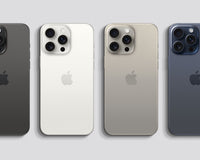Fighting climate change takes many forms. Painting a funny-yet-provocative slogan against meat consumption on your body and parading across London, recycling your old ginger ale bottles, buying responsibly sourced food… the list goes on. But have you ever thought about becoming part of a circular economy?
You may have overheard someone talking about the circular economy in your local, seen it in an environmental zine or watched a news report where it was mentioned. That’s because the circular economy is becoming an ever greater talking point in sustainability circles thanks to its potential to seriously tackle the climate crisis.
From fashion and food to the tech you use every day, the stats say it all:
📱 A refurbished smartphone saves 20,341.24 gallons (77,000 liters) of water
🧥 Circular fashion could reduce the industry’s carbon emissions by 16%
🍎 Reducing edible food waste by only 50% by 2030 has the potential to reduce annual emissions by 1.4 billion tonnes of CO2
What actually is a circular economy?
In simple terms, a circular economy is about making and buying less and instead reusing more of what is already in circulation. Whereas modern society has largely followed a take, make, waste mindset (known as a linear model), a circular economy or circular system involves reuse, repair, refurbishment, remanufacturing and recycling to create a closed-loop system.
The concept can be applied to a huge range of manufacturing industries, including fashion and technology – and it’s at the heart of our reduce, reuse, reboxed model.

What’s wrong with the current system?
Stuff. We love it. And our love for it is encouraged by big corporations whose aim is to convince us that we need more of it. From giant boards in public spaces to the screens we stare out, we’re almost constantly exposed to a slew of advertising battering us into buying a state-of-the-art dog brush or groundbreaking toaster (how groundbreaking can a toaster really be? Just one that goes beyond warming the bread but stops short of cremating it would be good).
In 2022 alone, the UK managed to rack up a whopping £441 billion in retail sales. This, ladies and gentlemen, is thanks in part to our linear economy and the take, make, waste mindset in which we buy, buy, buy – then throw it away only to basically buy the same thing again.
The rise of the fast fashion highlights how extreme the take, make, waste mindset has become in recent years. Take these findings from the World Economic Forum (WEF):
In the last 15 years the [fashion] industry has doubled production, while the time clothing is worn before it is thrown away has fallen by around 40%. When it is thrown away, 73% will be burned or buried in landfill. What does get collected for recycling – around 12% – will likely end up being shredded and used to stuff mattresses, or made into insulation or cleaning cloths. Less than 1% of what is collected will be used to make new clothing.
This has negative consequences for the environment and business, continue WEF.
These trends are not only damaging the environment, they are limiting the opportunities for the fashion industry to succeed in the long-term. The industry already misses out on $560 billion in value from clothing being worn less and barely recycled.
This means that there is a huge amount of untapped monetary potential sitting in products we have no problem throwing out. Thus, this entire linear economy system is costly in more ways than one, affecting both the planet and our bank accounts negatively.

The problem with tech
It isn’t just the fashion industry that loses in a non-circular economy: in fact, one of the biggest areas of waste within our linear economy is electronics and tech, aka e-waste.
According to figures from the UN, the world generated 53.6 mega-tonnes of e-waste in 2019. That is an increase of 480% compared to 2015 levels – and it is set to rise even further. The UN predicts that by 2030, this figure will have reached 74.7 mega-tonnes per year, which is an increase of 710% compared to 2015.

Sources: United Nations, The Global E-Waste Monitor 2020 and United Nations, Future E-waste Scenarios
Want to know something even more shocking? Less than 20% of that e-waste is recycled properly.
In contrast, the goal of a circular economy is to drastically reduce the level of waste produced at every stage of a product’s lifecycle as well as at its end-of-life: minimising unnecessary use of materials in the design, making it long lasting and repairable, ensuring that parts can be reused and, eventually, recycled.
Refurbish, reuse, reboxed
Things need to change. Our systems need a fundamental redesign, shifting away from a linear economy towards more circularity. This is beginning to happen in fashion, with apps such as Depop and sites such as ThredUp driving a boom in clothing resale figures: the global secondhand market is expected to rise from $28 billion in 2019 to $64 billion in 2024.
We want to do the same for tech: less landfill and carbon emissions, more refurbished, reused and reboxed.
This is how, like the fashion industry, we begin to create a new system – one that’s less linear and more circular. Refurbished devices are the solution.
Refurbished means that either the manufacturer or a specialist third party has worked on the phone to restore it to a better condition. The level of this work can vary from a minor change (such as screen replacement) to a complete re-manufacture (every part of the device is replaced).
And as anyone who struts like a peacock when they score a vintage bargain knows, second-hand doesn’t mean second best. All reboxed phones come with a free 12 month warranty and have been vigorously tested by our unique 70 point TechCheck®. They’re even packaged up to look as good as new.

Support our circular economy
Why not join our circular economy today and help be part of the movement to tackle the climate emergency and other related environmental problems (we’re looking at you, e-waste)?
As our planet enters a crucial period in the fight against climate change, we’re determined to create a new normal – a closed loop system where you can buy and sell phones within a community for a fair price. A system where e-waste is drastically reduced – and we all sleep a little better knowing we’ve saved a bit of cash as well as a device from landfill.
Buying reboxed saves a phone from the scrapheap. And when you’re done with it, it still doesn’t have to go to the scrapheap. Rebox it, sell it back to us and upgrade to another reboxed phone – keeping it circular all the way.






